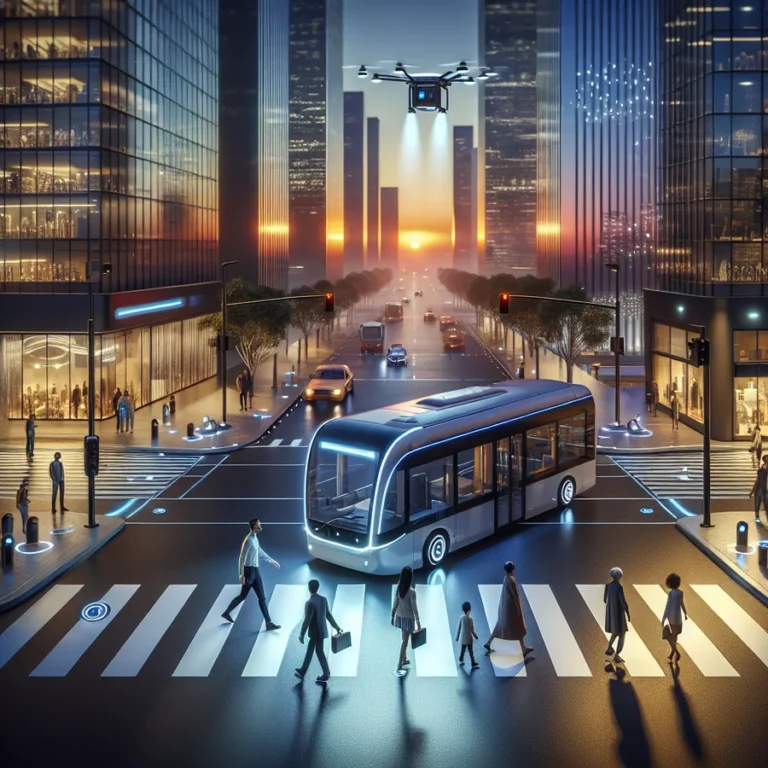AI in Transportation: Optimizing Routes and Improving Safety
Imagine a world with fewer traffic jams, safer roads, and more efficient commutes. That’s the promise of AI in transportation. Artificial intelligence is rapidly changing how we move people and goods, offering solutions to long-standing problems and creating exciting new possibilities.
This guide explores how AI in transportation is revolutionizing the industry. We’ll cover everything from optimizing routes and enhancing safety to reducing environmental impact and improving the overall passenger experience. Get ready to discover how AI is driving the future of transportation.
The Rise of AI in Transportation
The transportation industry is a complex web of factors. These include human behavior, economic conditions, and environmental concerns. This makes it ripe for innovation. Artificial Intelligence (AI) is emerging as a powerful tool to optimize this intricate system. By analyzing vast amounts of data, AI can predict disruptions, improve safety, and enhance overall efficiency.
The global market for AI in transportation is experiencing significant growth. In 2024, it was valued at approximately USD 2.11 billion. Projections estimate it will reach USD 6.51 billion by 2031. This reflects a compound annual growth rate (CAGR) of around 17.5% during the forecast period.
Key Drivers of Growth in AI Transportation
- Autonomous Vehicles: Self-driving cars and trucks promise to transform transportation. They can improve road safety, reduce congestion, and increase fuel efficiency.
- Intelligent Traffic Management: AI-powered systems optimize traffic flow and improve air quality. They use real-time data to identify bottlenecks and reroute traffic.
- Logistics Optimization: AI solutions streamline supply chains, reduce costs, and improve delivery times. AI can optimize route planning and predictive maintenance.
How AI is Used in Transportation
AI is being integrated into various aspects of transportation. It optimizes operations and enhances user experiences. Here are some of the most common applications:
- Autonomous Vehicles: AI enables self-driving cars, trucks, and buses. They navigate roads safely using sensors, cameras, and deep learning models.
- Traffic Prediction and Management: AI analyzes real-time and historical data. It optimizes traffic signals, reduces congestion, and improves urban mobility.
- Fleet Management: AI-driven systems help logistics companies. They monitor vehicle performance, optimize routes, and predict maintenance needs.
- Public Transit Optimization: AI enhances public transportation. It predicts demand, adjusts schedules, and improves passenger experiences.
- Smart Infrastructure: AI-powered road monitoring systems detect hazards. They automate toll collection and improve overall transportation efficiency.
With these AI applications, the transportation industry is evolving rapidly. This leads to improved mobility and cost savings for businesses and consumers alike.
Key Applications of AI in the Transportation Industry
AI is not just about innovation. It’s about practical solutions that enhance safety, efficiency, and cost-effectiveness. From predictive maintenance to advanced route optimization, AI is setting new standards in transportation operations.
1. Predictive Maintenance: Reducing Vehicle Downtime
Maintaining vehicle uptime is critical for efficiency and cost control. Unexpected breakdowns can disrupt operations and lead to significant expenses. Predictive maintenance uses AI to analyze sensor data and historical records. It identifies when vehicle components require servicing before problems occur.
AI uses data from IoT devices and machine learning models. This monitors equipment health and signals when support is needed. This prevents costly failures.
Benefits:
- Reduced downtime and repair costs
- Extended asset life
- Enhanced operational readiness
Example: Deutsche Bahn implemented AI to digitize maintenance. They drastically reduced inspection times and improved reliability.
2. Enhancing Road Safety with AI
Accurate detection and tracking of objects are essential. They improve safety and efficiency in transportation systems. AI-powered object detection and tracking systems use deep learning algorithms. They identify and monitor moving objects in real-time.
This technology uses visual data from cameras. This ensures that objects are tracked accurately across frames.
Benefits:
- Improved road safety
- Real-time vehicle tracking
- Enhanced driver assistance features
Example: Volvo’s ADAS and Tesla’s self-driving capabilities use AI. This is for collision avoidance, adaptive cruise control, and pedestrian safety.
3. Smart Traffic Management: Optimizing Traffic Flow
Managing transportation networks efficiently is key. It reduces congestion, improves safety, and minimizes environmental impact. Intelligent Transportation Systems (ITS) combine advanced technologies. These include AI, IoT, and data analytics. They optimize traffic flow and decision-making.
These systems analyze real-time data from sensors, cameras, and vehicles. This improves decision-making in traffic management, public transit, and logistics.
Benefits:
- Reduced traffic congestion
- Enhanced road safety
- Improved public transit efficiency
- Lower emissions and fuel consumption
Example: Singapore’s Smart Mobility 2030 initiative uses ITS. It integrates AI in traffic monitoring, dynamic toll pricing, and public transit scheduling. This significantly reduces congestion and travel times.
4. Inspecting Hard-to-Reach Areas with AI
Infrastructure inspections and surveillance often require solutions. These can navigate challenging or inaccessible areas. Drones equipped with AI algorithms offer high-resolution imagery and real-time analysis. This makes them ideal for infrastructure inspections, security surveillance, and traffic management.
Benefits:
- Increased inspection accuracy
- Faster response to incidents
- Lower operational costs
Example: The Port of Rotterdam employs drones. They inspect installations, control damage, and respond to incidents.
5. Streamlining Traffic and Toll Operations Using AI
Managing traffic flow and enforcing regulations require precise and efficient identification of vehicles. AI-powered license plate recognition (LPR) systems use computer vision and deep learning. They accurately read and identify vehicle license plates.
These systems are commonly applied in traffic law enforcement, toll collection, parking management, and vehicle tracking.
Benefits:
- Enhanced security and surveillance
- Streamlined toll collection and traffic flow
- Improved logistics operations
Example: In New York, an AI-driven LPR system scanned 16 million plates weekly. This aided in the interception of a drug suspect by analyzing route patterns.
6. Ensuring Driver Safety with AI
Maintaining driver focus is crucial. It prevents accidents and enhances road safety. Driver monitoring systems (DMS) enhanced by AI track driver behavior. They detect signs of fatigue, distraction, or unsafe actions.
These systems use cameras and AI algorithms. They monitor facial expressions, eye movements, and head position. This ensures drivers remain attentive. The data collected can trigger alerts or adjustments to prevent accidents.
Benefits:
- Accurate risk assessment
- Real-time operational insights
- Cost-efficient insurance plans
Example: Cipia partnered with Chery. They implemented AI-based driver monitoring. This detects unsafe actions like seatbelt neglect and phone use.
7. Optimizing Fleet Operations with AI
Efficient fleet management requires real-time insights. These insights include vehicle performance, driver behavior, and operational needs. AI-integrated telematics systems collect and analyze vehicle data. This provides insights into performance, driver behavior, and maintenance needs.
Combining AI with telematics allows fleet managers to monitor routes. It ensures compliance with regulations and optimizes fleet operations. Advanced AI algorithms help predict maintenance needs. They provide real-time alerts for route deviations or unauthorized vehicle use.
Benefits:
- Accurate risk assessment
- Real-time operational insights
- Cost-efficient insurance plans
Example: Euristiq developed a cloud-based IoT platform with video telematics. This was for a fleet insurance company. It enhanced safety and compliance.
8. Reducing Travel Time and Costs with AI
Efficient route planning is essential. It minimizes travel time, reduces costs, and improves logistics performance. AI-powered route optimization goes beyond traditional methods. It analyzes multiple variables. These include traffic patterns, weather conditions, and road closures.
This advanced approach determines the most efficient paths. This ensures timely deliveries, lower fuel consumption, and enhanced operational efficiency.
Benefits:
- Reduced fuel consumption and operational costs
- Enhanced environmental sustainability
- Improved delivery schedules
Example: UPS’s ORION system uses AI. It saves 100 million miles and 10 million gallons of fuel annually.
9. Streamlining Last-Mile Logistics with AI
The last mile of delivery is the most complex and costly part of the supply chain. It requires precise planning. This ensures efficiency and customer satisfaction. AI-driven last-mile delivery optimization analyzes real-time traffic, package volumes, and delivery locations. This creates efficient routes and schedules.
This approach reduces costs, improves delivery speed, and enhances customer experience, even in dense urban areas.
Benefits:
- Increased delivery efficiency
- Higher customer satisfaction
- Cost-effective logistics management
Example: Amazon uses AI-driven logistics. This is for efficient last-mile delivery. It ensures timely arrivals even in congested urban areas.
10. AI-Enhanced Traffic Management
AI is transforming how cities manage traffic. It helps reduce traffic congestion. It also improves traffic flow by analyzing real-time traffic data. Smart systems make roads safer and more efficient for drivers.
In the transportation sector, AI can show where new roads or public transit might be needed. This enhances operational efficiency. This integration of AI-driven technologies is crucial for predictive maintenance and data reliance within the industry.
Advantages of AI in Transportation
AI technologies are reshaping transportation. They introduce efficiency, precision, and scalability to key operations. From optimizing routes to reducing costs, AI provides measurable business benefits. It also improves safety and sustainability.
- Operational Efficiency: AI enhances transportation systems. It automates complex processes like route planning and fleet coordination. This leads to faster and more reliable operations.
- Cost Savings: Predictive maintenance tools reduce unexpected repair costs. AI-powered fuel optimization lowers consumption. This cuts operational expenses for logistics and transportation companies.
- Safety Improvements: Systems leveraging AI analyze vehicle and road data. They detect potential hazards and prevent accidents. This enhances compliance and overall safety standards.
- Data-Backed Insights: AI processes large-scale transportation data in real time. It offers actionable insights on congestion patterns and shipment status.
- Passenger Customization: Personalization tools powered by AI adjust ticket prices. They also adjust seating options and service recommendations. This boosts customer satisfaction.
- Environmental Impact Reduction: AI minimizes emissions. It does this through better fuel management and efficient routing. This supports sustainability objectives.
Disadvantages of AI in Transportation
While AI promises to revolutionize transportation, it comes with a set of challenges we need to address. Here are some of the main hurdles:
- High Upfront Costs: The initial investment in sensors, software, and hardware can be significant. This can leave smaller players struggling to keep up.
- Job Displacement: AI excels at automation. This can come at the cost of human jobs. Concerns regarding workforce displacement are real.
- Ethical and Liability Dilemmas: Accidents involving autonomous vehicles raise complex questions. Who is responsible? The manufacturer, the software developer, or even the passenger?
- Cybersecurity Concerns: AI systems are vulnerable to attacks. These could compromise passenger safety and disrupt entire networks. Collecting mountains of data raises privacy concerns.
- Limited Decision-Making Skills: AI shines in analyzing data and making predictable choices. However, when faced with novel situations, AI can fall short.
- Resistance to Adoption: Fear of job losses and regulatory hurdles can create resistance. Cultural barriers can further impede the acceptance of new technology.
- Integration Woes: Merging AI with existing infrastructure can be tricky. Compatibility issues can lead to data-sharing difficulties.
- Overreliance on Technology: Excessive dependence on AI can be risky. Technical failures could lead to breakdowns or accidents.
- Data Quality Matters: AI relies heavily on clean, accurate data. Poor data quality fuels inaccurate predictions.
- Skilled Workforce Gap: Finding the talent to manage these complex AI systems is a challenge. Training existing staff can be a resource drain.
While AI has the potential to enhance transportation, addressing these challenges is critical. This is not just about the technology. It is also about the people and the systems that support it.
Ethical Considerations in AI-Driven Transportation
The integration of AI in transportation presents a new set of ethical challenges. While self-driving cars offer numerous benefits, they also raise critical questions regarding safety and public trust.
1. Safety Concerns
Responsibility in Accidents: Determining liability in accidents involving AVs is complex. When an AV is at fault, the blame could fall on the manufacturer, software developer, or even the passenger.
Risk of Malfunctions: AVs rely heavily on software and sensors. This makes them susceptible to malfunctions due to software bugs or hacking. This can lead to safety risks.
2. Decision-Making Algorithms
Moral Algorithms: Programming AVs to make ethical decisions in unavoidable crash scenarios is a major challenge. The debate revolves around whether an AV should prioritize the safety of its passengers or pedestrians.
Bias in AI: Ensuring that AI algorithms are free from biases is crucial. This could lead to discriminatory practices in navigation or pedestrian recognition.
3. Public Trust and Acceptance
Transparency and Explainability in AI Systems: Building public trust requires transparency in how AVs operate and make decisions. This is challenging given the complexity of AI algorithms.
Legal and Regulatory Framework: Establishing comprehensive legal frameworks is essential. This governs the use and safety standards of AVs. This is for gaining public trust.
Key Considerations for an AI Strategy
As the transportation industry evolves, more companies are looking to integrate AI. Some aim to keep up with competition. Others see AI’s real value in reducing costs and boosting efficiency. Budget is often a concern. Not all companies are ready to invest heavily in new technologies.
But AI doesn’t always require massive budgets. When approached strategically, it can deliver impressive results and significant benefits.
AI and machine learning (ML) are key parts of digital transformation. Leveraging them effectively can give your business a real edge. However, AI/ML is complex. It is best handled by experienced professionals. Businesses often struggle with knowledge gaps. It’s wise to consider working with experts to develop and implement a successful AI strategy.
Step 1. Define Clear Business Objectives
- Identify key goals for integrating AI. Can manual processes benefit from automation?
- Think about how AI can improve your operational workflows. Could AI streamline fleet management or improve route optimization?
Step 2. Assess Data Readiness
- Evaluate your company’s capacity to gather and manage the data necessary for AI.
- Identify potential data sources and consider challenges you may face. Clean data is essential for effective AI implementation.
Step 3. Build a Strong AI Team
- Do you have AI/ML expertise within your team, or will you need external support?
- Consider your current resources to support AI implementation. Determine where you might need additional expertise.
Step 4. Integrate AI into Existing Systems
- Assess how AI technologies integrate with your IT setup and software systems.
- Anticipate compatibility challenges. Make a plan to address any potential integration issues before implementation begins.
Step 5. Scalability and Future-Proofing
- Can your current infrastructure support the increasing demands of AI as your business grows?
- Ensure your AI solutions are scalable. This accommodates future growth so they continue delivering value over time.
Building an AI strategy doesn’t have to be overwhelming. When done thoughtfully, it can provide significant advantages for your business.
The Future of AI in Transportation
AI is set to transform transportation. It will make it safer, more efficient, and more accessible. Ongoing research and thoughtful policy development will be key. This realizes the full potential of AI in this sector.
- Autonomous Vehicles: Self-driving cars and trucks are at the forefront of AI in transportation.
- Traffic Management: AI-driven systems are optimizing traffic flow and reducing congestion.
- Public Transportation: AI is improving public transit through predictive maintenance and real-time scheduling.
- Logistics and Freight: AI is streamlining supply chains by optimizing routes and predicting demand.
- Air Mobility: The concept of urban air mobility is gaining traction. AI plays a crucial role in the development of autonomous drones and air taxis.
Conclusion
AI in transportation is revolutionizing how we move. It’s optimizing routes, enhancing safety, and creating a more sustainable future. While challenges remain, the potential benefits are undeniable. By embracing AI and addressing its ethical implications, we can unlock a new era of efficient, safe, and environmentally friendly transportation for all.
Frequently Asked Questions
How does AI improve traffic management?
AI analyzes real-time data from various sources to optimize traffic flow. It adjusts traffic signal timings dynamically. This reduces congestion and improves overall urban mobility.
What are the benefits of predictive maintenance in transportation?
Predictive maintenance uses AI to analyze sensor data. It identifies potential mechanical issues before they become serious problems. This reduces downtime, lowers repair costs, and enhances reliability.
How do autonomous vehicles use AI?
Autonomous vehicles rely on AI technologies. These include computer vision, machine learning, and sensor fusion. This allows them to navigate complex environments safely and make real-time driving decisions.
What are the ethical considerations of AI in transportation?
Ethical considerations include determining liability in accidents involving AVs. It also includes ensuring AI algorithms are free from biases. Building public trust through transparency is also important.
How can AI reduce the environmental impact of transportation?
AI optimizes fuel consumption by recommending efficient routes. It manages traffic flow to minimize idle time. It also supports electric vehicle infrastructure by predicting energy demand.






